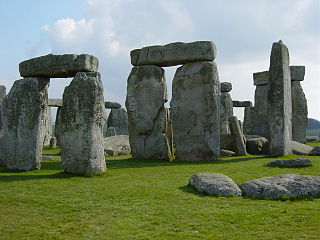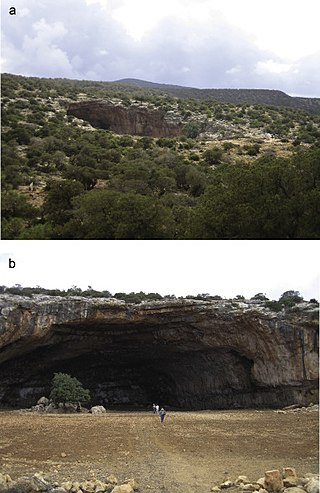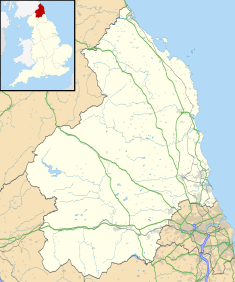
Several species of humans have intermittently occupied Great Britain for almost a million years. The earliest evidence of human occupation around 900,000 years ago is at Happisburgh on the Norfolk coast, with stone tools and footprints probably made by Homo antecessor. The oldest human fossils, around 500,000 years old, are of Homo heidelbergensis at Boxgrove in Sussex. Until this time Britain had been permanently connected to the Continent by a chalk ridge between South East England and northern France called the Weald-Artois Anticline, but during the Anglian Glaciation around 425,000 years ago a megaflood broke through the ridge, and Britain became an island when sea levels rose during the following Hoxnian interglacial.

Aetokremnos is a rock shelter near Limassol on the southern coast of Cyprus. It is situated on a steep cliff site c. 40 m (131.23 ft) above the Mediterranean sea. The name means "Cliff of the eagles" in Greek. Around 40 m2 (430.56 sq ft) have been excavated and out of the four layers documented, the third is sterile.

Star Carr is a Mesolithic archaeological site in North Yorkshire, England. It is around five miles (8 km) south of Scarborough. It is generally regarded as the most important and informative Mesolithic site in Great Britain. It is as important to the Mesolithic period as Stonehenge is to the Neolithic period or Scandinavian York is to understanding Viking Age Britain.

Archaeology and geology continue to reveal the secrets of prehistoric Scotland, uncovering a complex past before the Romans brought Scotland into the scope of recorded history. Successive human cultures tended to be spread across Europe or further afield, but focusing on this particular geographical area sheds light on the origin of the widespread remains and monuments in Scotland, and on the background to the history of Scotland.

Burry Holms, a tidal island with the height of is at the northern end of Rhossili Bay in the Gower Peninsula, Wales. During spring and summer, Burry Holms is covered by flowers such as thrift and sea campion.

The Mount Sandel Mesolithic site is in Coleraine, County Londonderry, Northern Ireland, just to the east of the Iron Age Mount Sandel Fort. It is one of the oldest archaeological sites in Ireland with carbon dating indicating an age of 9,000 years old (7,000BC). Gwendoline Cave, County Clare is the only site in Ireland with evidence of human occupation which pre-dates this location. Mount Sandel Mesolithic site is a Scheduled Historic Monument in the townland of Mount Sandel, in Causeway Coast and Glens Council area, at Grid Ref: C8533 3076. It was excavated by Peter Woodman in the 1970s.

This timeline of prehistoric Scotland is a chronologically ordered list of important archaeological sites in Scotland and of major events affecting Scotland's human inhabitants and culture during the prehistoric period. The period of prehistory prior to occupation by the genus Homo is part of the geology of Scotland. Prehistory in Scotland ends with the arrival of the Romans in southern Scotland in the 1st century AD and the beginning of written records. The archaeological sites and events listed are the earliest examples or among the most notable of their type.
Events from the prehistory of Britain.

Prehistoric Orkney refers only to the prehistory of the Orkney archipelago of Scotland that begins with human occupation. Although some records referring to Orkney survive that were written during the Roman invasions of Scotland, “prehistory” in northern Scotland is defined as lasting until the start of Scotland's Early Historic Period.

Hawkcombe Woods is a national nature reserve near Porlock on Exmoor, Somerset, England.

The Neolithic period in the British Isles lasted from c. 4100 to c. 2,500 BC. Constituting the final stage of the Stone Age in the region, it was preceded by the Mesolithic and followed by the Bronze Age.
The Duvensee archaeological sites are a series of early Mesolithic archaeological sites that are located within the Duvensee bog near Duvensee in Schleswig Holstein, Germany. The bog is one of the oldest and well-researched archaeological settlement areas from the early Holocene in Central Europe. The archaeological sites are renowned for their well-preserved organic remains and are of great importance in understanding the subsistence and settlement strategies of post-glacial hunter-gatherer societies. Recent research has explored the Duvensee societies' diet and land use patterns in relation to the evolution of modern lifestyles and nutrition.
Bedburg-Königshoven is a Mesolithic site where two head-dresses were discovered from Red deer antlers and skulls. They are often believed to be the oldest traces of shamanic and religious behaviour.
Nicola Jane Milner is a British archaeologist and academic. She is head of the Department of Archaeology at the University of York. Her research focuses on the Mesolithic period, and the transition between the Mesolithic and Neolithic. She has worked at the iconic site of Star Carr in the Vale of Pickering for over 15 years, and has directed excavations at the site since 2004.

Haua Fteah is a large karstic cave located in the Cyrenaica in northeastern Libya. This site has been of significance to research on African archaeological history and anatomically modern human prehistory because it was occupied during the Middle and Upper Paleolithic, the Mesolithic and the Neolithic. Evidence of modern human presence in the cave date back to 200,000 BP.
Elands Bay Cave is located near the mouth of the Verlorenvlei estuary on the Atlantic coast of South Africa's Western Cape Province. The climate has continuously become drier since the habitation of hunter-gatherers in the Later Pleistocene. The archaeological remains recovered from previous excavations at Elands Bay Cave have been studied to help answer questions regarding the relationship of people and their landscape, the role of climate change that could have determined or influenced subsistence changes, and the impact of pastoralism and agriculture on hunter-gatherer communities.
Melkhoutboom Cave is an archaeological site dating to the Later Stone Age, located in the Zuurberg Mountains, Cape Folded Mountain Belt, in the Addo Elephant National Park, Sarah Baartman District Municipality in the Eastern Cape Province of South Africa.

The Iron Gates Mesolithic is a Mesolithic archaeological culture dated to between 13,000 and 6,000 years cal BCE, in the Iron Gates region of the Danube River, in modern Romania and Serbia.

Paleo Crossing site, also known as the Old Dague Farm site, is an archaeological site near Sharon Center, Ohio in Medina County where Clovis artifacts dated to 10,980 BP ± 75 years Before Present were found. The Cleveland Museum of Natural History conducted an excavation from 1990 to 1993. The site provides evidence of Paleo-Indians in northern Ohio and may be the area's oldest residents and archaeologist Dr. David Brose believes that they may be "some of the oldest certain examples of human activity in the New World." The site contains charcoal recovered from refuse pits. There were also two post holes and blades and tools 80% of which were made from flint from the Ohio River Valley in Indiana, 500 miles from Paleo Crossing, which indicates that the hunter-gatherers had a widespread social network and traveled across distances relatively quickly. The post holes are evidence that there was a shelter built on the site.

Lismore Fields is the site of a Stone Age settlement in the town of Buxton, Derbyshire, England. It was discovered close to the River Wye in 1984 by the Trent and Peak Archaeological Trust during a search for a Roman road. The site is a protected Scheduled Monument.













